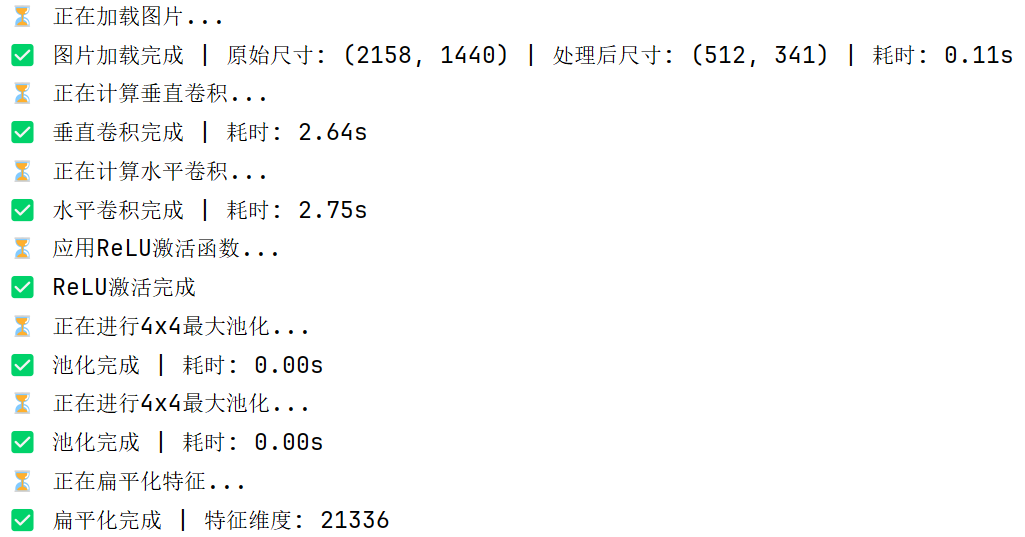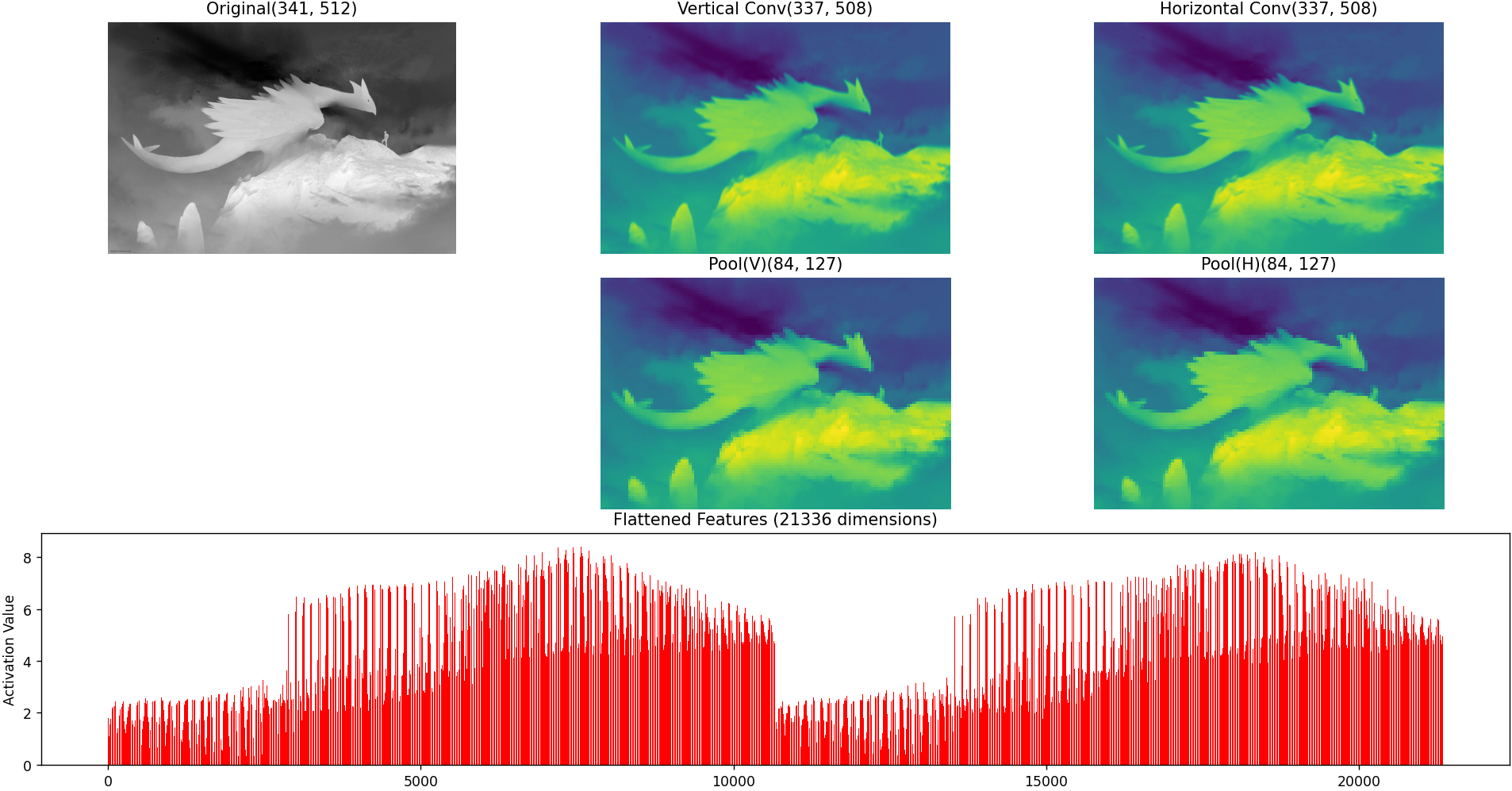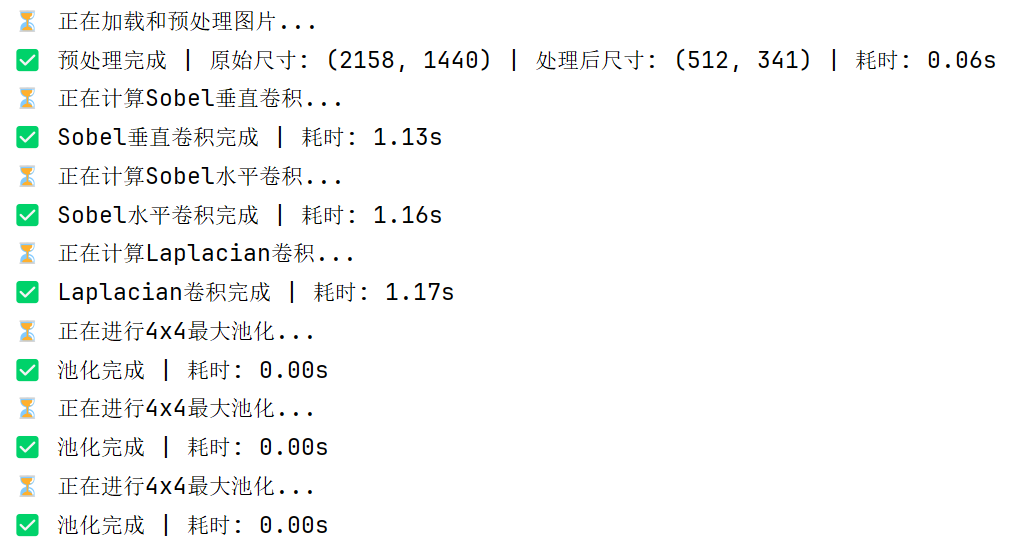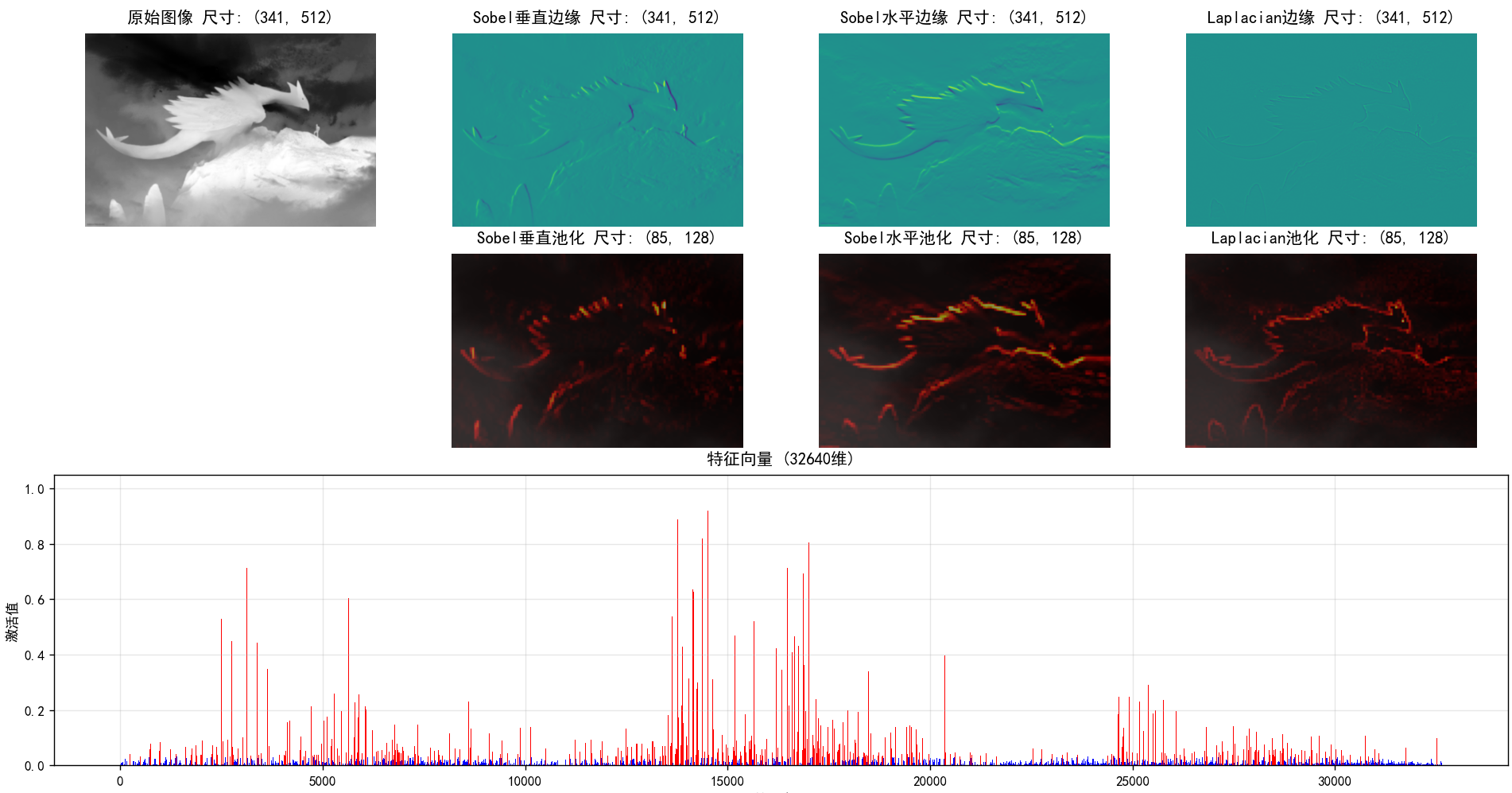前言
心血来潮想把下面的又矩阵换成图片看一下,但是图像像素点太多了,处理效果不是很明显,后面用其他的卷积核弄了一下。
特征提取
代码实现了一个基于卷积神经网络(CNN)的图像特征提取流程,首先加载并预处理灰度图像(调整大小、归一化和反色),然后分别使用5×5的垂直和水平边缘检测卷积核进行特征提取,接着通过ReLU激活函数引入非线性并去除负值,再经过4×4的最大池化降低特征图维度,最后将两个方向的池化特征展平拼接成一维向量。整个过程模拟了CNN的特征提取过程,并通过可视化展示了各阶段(原始图像、卷积结果、池化特征和扁平化向量)的处理效果,有助于理解图像在CNN中的特征变换过程。
# 定义更大的卷积核(5x5)
kernel_v = np.array([
[0, 0.5, 1, 0.5, 0],
[0, 0.5, 1, 0.5, 0],
[0, 0.5, 1, 0.5, 0],
[0, 0.5, 1, 0.5, 0],
[0, 0.5, 1, 0.5, 0]
]) # 垂直边缘检测
kernel_h = np.array([
[0, 0, 0, 0, 0],
[0.5, 0.5, 0.5, 0.5, 0.5],
[1, 1, 1, 1, 1],
[0.5, 0.5, 0.5, 0.5, 0.5],
[0, 0, 0, 0, 0]
]) # 水平边缘检测import numpy as np
import matplotlib.pyplot as plt
from PIL import Image
from skimage.util import view_as_blocks
import time
def load_and_resize_image(image_path, max_size=512): # 增大默认尺寸以保留更多细节
"""加载图片并等比例缩小"""
print("⏳ 正在加载图片...")
start_time = time.time()
img = Image.open(image_path).convert('L')
original_size = img.size
# 等比例缩小
ratio = min(max_size / original_size[0], max_size / original_size[1])
new_size = (int(original_size[0] * ratio), int(original_size[1] * ratio))
img = img.resize(new_size, Image.LANCZOS)
img_array = np.array(img)
img_array = img_array / 255.0 # 归一化
img_array = 1 - img_array # 反色
print(
f"✅ 图片加载完成 | 原始尺寸: {original_size} | 处理后尺寸: {new_size} | 耗时: {time.time() - start_time:.2f}s")
return img_array
def conv2d(image, kernel, operation_name=""):
"""带进度提示的2D卷积"""
print(f"⏳ 正在计算{operation_name}卷积...")
start_time = time.time()
h, w = image.shape
k_h, k_w = kernel.shape
output = np.zeros((h - k_h + 1, w - k_w + 1))
total_steps = h - k_h + 1
for y in range(h - k_h + 1):
if y % 10 == 0 or y == total_steps - 1:
print(f" 进度: {y + 1}/{total_steps}行", end='\r')
for x in range(w - k_w + 1):
output[y, x] = np.sum(image[y:y + k_h, x:x + k_w] * kernel)
print(f"✅ {operation_name}卷积完成 | 耗时: {time.time() - start_time:.2f}s")
return output
def maxpool2d(image, pool_size=4): # 增大默认池化尺寸
"""最大池化"""
print(f"⏳ 正在进行{pool_size}x{pool_size}最大池化...")
start_time = time.time()
h, w = image.shape
h = h - h % pool_size
w = w - w % pool_size
image = image[:h, :w]
blocks = view_as_blocks(image, (pool_size, pool_size))
pooled = blocks.max(axis=2).max(axis=2)
print(f"✅ 池化完成 | 耗时: {time.time() - start_time:.2f}s")
return pooled
def visualize_full_process(original, conv_v, conv_h, relu_v, relu_h, pool_v, pool_h, flattened):
"""完整可视化处理流程"""
plt.figure(figsize=(18, 12)) # 增大画布尺寸
# 原始图像
plt.subplot(3, 3, 1)
plt.imshow(original, cmap='gray')
plt.title(f'Original{original.shape}')
plt.axis('off')
# 垂直卷积
plt.subplot(3, 3, 2)
plt.imshow(conv_v, cmap='viridis')
plt.title(f'Vertical Conv{conv_v.shape}')
plt.axis('off')
# 水平卷积
plt.subplot(3, 3, 3)
plt.imshow(conv_h, cmap='viridis')
plt.title(f'Horizontal Conv{conv_h.shape}')
plt.axis('off')
# 池化垂直
plt.subplot(3, 3, 5)
plt.imshow(pool_v, cmap='viridis')
plt.title(f'Pool(V){pool_v.shape}')
plt.axis('off')
# 池化水平
plt.subplot(3, 3, 6)
plt.imshow(pool_h, cmap='viridis')
plt.title(f'Pool(H){pool_h.shape}')
plt.axis('off')
# 扁平化特征
plt.subplot(3, 1, 3)
plt.bar(range(len(flattened)), flattened, color=['red' if x > 0 else 'blue' for x in flattened])
plt.title(f'Flattened Features ({len(flattened)} dimensions)')
plt.xlabel('Feature Index')
plt.ylabel('Activation Value')
plt.tight_layout()
plt.show()
def process_image(image_path, max_size=512, pool_size=4): # 增大默认参数
"""完整的图像处理流程"""
print("\n" + "=" * 50)
print("🚀 开始图像处理流程")
print("=" * 50)
# 1. 加载和预处理
original = load_and_resize_image(image_path, max_size)
# 定义更大的卷积核(5x5)
kernel_v = np.array([
[0, 0.5, 1, 0.5, 0],
[0, 0.5, 1, 0.5, 0],
[0, 0.5, 1, 0.5, 0],
[0, 0.5, 1, 0.5, 0],
[0, 0.5, 1, 0.5, 0]
]) # 垂直边缘检测
kernel_h = np.array([
[0, 0, 0, 0, 0],
[0.5, 0.5, 0.5, 0.5, 0.5],
[1, 1, 1, 1, 1],
[0.5, 0.5, 0.5, 0.5, 0.5],
[0, 0, 0, 0, 0]
]) # 水平边缘检测
# 2. 卷积
conv_v = conv2d(original, kernel_v, "垂直")
conv_h = conv2d(original, kernel_h, "水平")
# 3. ReLU激活
print("⏳ 应用ReLU激活函数...")
relu_v = np.maximum(0, conv_v)
relu_h = np.maximum(0, conv_h)
print("✅ ReLU激活完成")
# 4. 池化
pool_v = maxpool2d(relu_v, pool_size)
pool_h = maxpool2d(relu_h, pool_size)
# 5. 扁平化
print("⏳ 正在扁平化特征...")
flattened = np.concatenate([pool_v.flatten(), pool_h.flatten()])
print(f"✅ 扁平化完成 | 特征维度: {len(flattened)}")
# 可视化
visualize_full_process(original, conv_v, conv_h, relu_v, relu_h, pool_v, pool_h, flattened)
return {
'original': original,
'conv_v': conv_v,
'conv_h': conv_h,
'relu_v': relu_v,
'relu_h': relu_h,
'pool_v': pool_v,
'pool_h': pool_h,
'flattened': flattened
}
# 使用示例
if __name__ == "__main__":
image_path = "image.jpg" # 替换为你的图片路径
results = process_image(image_path, max_size=512, pool_size=4) # 使用更大的参数

优化版
代码实现了一个增强版的图像特征提取流程,首先通过直方图均衡化和高斯滤波对图像进行增强预处理,然后使用三种不同的卷积核(Sobel垂直/水平边缘检测和Laplacian边缘增强)进行多尺度特征提取,并采用ReLU激活函数处理卷积结果;接着通过自适应最大池化降低特征维度,最后将多组特征归一化后拼接成综合特征向量。改进后的流程通过更专业的卷积核、反射填充边界和特征融合技术提升了特征提取效果,并采用优化的可视化布局同时展示原始图像、三类卷积结果、叠加显示的池化热力图以及最终的特征向量分布,完整呈现了从原始图像到高级特征的转换过程。
kernels = {
'Sobel垂直': np.array([[-1, -2, 0, 2, 1],
[-2, -4, 0, 4, 2],
[-1, -2, 0, 2, 1]]) / 8,
'Sobel水平': np.array([[-1, -2, -1],
[-2, -4, -2],
[0, 0, 0],
[2, 4, 2],
[1, 2, 1]]) / 8,
'Laplacian': np.array([[0, 1, 0],
[1, -4, 1],
[0, 1, 0]])
}import numpy as np
import matplotlib.pyplot as plt
from PIL import Image
from skimage.util import view_as_blocks
from skimage import exposure
from scipy.ndimage import gaussian_filter
import time
import matplotlib
# 设置中文字体
plt.rcParams['font.sans-serif'] = ['SimHei'] # Windows系统
plt.rcParams['axes.unicode_minus'] = False
def load_and_preprocess_image(image_path, max_size=512):
"""加载图片并进行增强预处理"""
print("⏳ 正在加载和预处理图片...")
start_time = time.time()
img = Image.open(image_path).convert('L')
original_size = img.size
# 修正后的尺寸计算行
ratio = min(max_size / original_size[0], max_size / original_size[1])
new_size = (int(original_size[0] * ratio), int(original_size[1] * ratio))
img = img.resize(new_size, Image.LANCZOS)
img_array = np.array(img, dtype=np.float32)
img_array = exposure.equalize_hist(img_array)
img_array = gaussian_filter(img_array, sigma=0.8)
img_array = (img_array - img_array.min()) / (img_array.max() - img_array.min())
img_array = 1 - img_array
print(f"✅ 预处理完成 | 原始尺寸: {original_size} | 处理后尺寸: {new_size} | 耗时: {time.time() - start_time:.2f}s")
return img_array
def enhanced_conv2d(image, kernel, operation_name=""):
"""增强版卷积运算"""
print(f"⏳ 正在计算{operation_name}卷积...")
start_time = time.time()
pad_h = kernel.shape[0] // 2
pad_w = kernel.shape[1] // 2
padded = np.pad(image, ((pad_h, pad_h), (pad_w, pad_w)), mode='reflect')
h, w = image.shape
k_h, k_w = kernel.shape
output = np.zeros_like(image)
total_steps = h
for y in range(h):
if y % 10 == 0 or y == total_steps - 1:
print(f" 进度: {y + 1}/{total_steps}行", end='\r')
for x in range(w):
output[y, x] = np.sum(padded[y:y + k_h, x:x + k_w] * kernel)
print(f"✅ {operation_name}卷积完成 | 耗时: {time.time() - start_time:.2f}s")
return output
def adaptive_maxpool(image, pool_size=4):
"""自适应最大池化"""
print(f"⏳ 正在进行{pool_size}x{pool_size}最大池化...")
start_time = time.time()
h, w = image.shape
h = h - h % pool_size
w = w - w % pool_size
image = image[:h, :w]
blocks = view_as_blocks(image, (pool_size, pool_size))
pooled = blocks.max(axis=2).max(axis=2)
print(f"✅ 池化完成 | 耗时: {time.time() - start_time:.2f}s")
return pooled
def visualize_enhanced_results(original, conv_results, pool_results, flattened):
"""改进版可视化(优化布局)"""
plt.figure(figsize=(16, 12))
# 调整全局参数
plt.rcParams['axes.titlepad'] = 8
plt.subplots_adjust(left=0.05, right=0.95, bottom=0.05, top=0.92,
wspace=0.15, hspace=0.3)
# 创建2x4的网格布局
gs = plt.GridSpec(3, 4, height_ratios=[1, 1, 1.5])
# 1. 原始图像
ax0 = plt.subplot(gs[0, 0])
ax0.imshow(original, cmap='gray')
ax0.set_title('原始图像 尺寸: {}'.format(original.shape))
ax0.axis('off')
# 2-4. 卷积结果
titles = ['Sobel垂直边缘', 'Sobel水平边缘', 'Laplacian边缘']
for idx, (name, conv) in enumerate(conv_results.items(), start=1):
ax = plt.subplot(gs[0, idx])
ax.imshow(conv, cmap='viridis', vmin=-1, vmax=1)
ax.set_title('{} 尺寸: {}'.format(titles[idx - 1], conv.shape))
ax.axis('off')
# 5-7. 池化结果
titles = ['Sobel垂直池化', 'Sobel水平池化', 'Laplacian池化']
for idx, (name, pool) in enumerate(pool_results.items(), start=1):
ax = plt.subplot(gs[1, idx])
ax.imshow(original, cmap='gray')
ax.imshow(pool, cmap='hot', alpha=0.5)
ax.set_title('{} 尺寸: {}'.format(titles[idx - 1], pool.shape))
ax.axis('off')
# 8. 特征向量 (占据底部一整行)
ax7 = plt.subplot(gs[2, :])
colors = ['red' if x > np.mean(flattened) else 'blue' for x in flattened]
ax7.bar(range(len(flattened)), flattened, color=colors, width=1.0)
ax7.set_title('特征向量 ({}维)'.format(len(flattened)))
ax7.set_xlabel('特征索引')
ax7.set_ylabel('激活值')
ax7.grid(True, alpha=0.3)
plt.suptitle(' ', y=0.98, fontsize=16)
plt.tight_layout()
plt.show()
def enhanced_feature_extraction(image_path, max_size=512, pool_size=4):
"""增强版特征提取流程"""
print("\n" + "=" * 50)
print("🚀 开始增强版特征提取流程")
print("=" * 50)
original = load_and_preprocess_image(image_path, max_size)
kernels = {
'Sobel垂直': np.array([[-1, -2, 0, 2, 1],
[-2, -4, 0, 4, 2],
[-1, -2, 0, 2, 1]]) / 8,
'Sobel水平': np.array([[-1, -2, -1],
[-2, -4, -2],
[0, 0, 0],
[2, 4, 2],
[1, 2, 1]]) / 8,
'Laplacian': np.array([[0, 1, 0],
[1, -4, 1],
[0, 1, 0]])
}
conv_results = {}
for name, kernel in kernels.items():
conv = enhanced_conv2d(original, kernel, name)
conv_results[name] = conv
relu_results = {name: np.maximum(0, conv) for name, conv in conv_results.items()}
combined_feature = np.max(list(relu_results.values()), axis=0)
pool_results = {}
for name, feature in relu_results.items():
pool_results[name] = adaptive_maxpool(feature, pool_size)
flattened = np.concatenate([pool.flatten() for pool in pool_results.values()])
flattened = (flattened - np.min(flattened)) / (np.max(flattened) - np.min(flattened))
visualize_enhanced_results(original, conv_results, pool_results, flattened)
return {
'original': original,
'conv_results': conv_results,
'pool_results': pool_results,
'flattened_features': flattened
}
if __name__ == "__main__":
image_path = "image.jpg" # 替换为你的图片路径
results = enhanced_feature_extraction(image_path)
